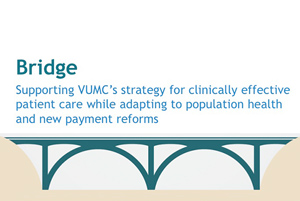Improvements in how patients’ preventive health care needs are identified, documented and tracked are being implemented at Vanderbilt University Medical Center (VUMC) through an initiative called Bridge, the aim of which is to increase the ability of both VUMC and the Vanderbilt Health Affiliated Network to deliver care in a more cohesive manner rather than as a series of individual encounters.
Bridge is designed to keep clinicians informed about their progress toward meeting specific patient care quality measures as health care in the United States moves toward a greater focus on health promotion and clinical effectiveness. In addition, the work aligns with the national movement toward value-based, pay-for-performance models to reimburse clinicians and health systems for how they manage the overall health of their patients.
“We knew early on that we needed tools to reliably track and better document our performance on quality measures now that all health care professionals are being held accountable under the new reimbursement models,” said David Posch, executive vice president for Population Health.
“We quickly assembled the best team — project management, informatics experts, quality consultants and clinical leaders — to address the challenge, and they worked continually throughout 2016. Our goal was to develop the right systems, technology and processes so we can make it as easy as possible for our clinicians to deliver the most efficient, highest quality care to the patients we serve. This is who we are.”
Eleven quality measures were identified as the first wave of measures to track. These include:
• Diabetes eye exam (annually for diabetes patients)
• A1C screening (for diabetes patients)
• Colorectal cancer screening (for ages 50-75)
• Breast cancer screening (every two years for females, ages 50-75)
• Adult body mass index assessment (annually for ages 18 and older)
• High-risk medications check (for ages 66 and older)
• Pneumococcal vaccine (for ages 65 and older)
• Influenza immunization (for ages six months and older)
• Well child visits (0-15 months)
• Well child visits (3-6 years)
• Pediatric upper respiratory infection treatment (ages 3 months-18 years)
“Because meeting these quality measures is critical to providing better patient care and to fulfilling new requirements that are the result of payment reform, goals for the first eight measures have been incorporated into VUMC’s Pillar Goals for fiscal year 2017,” said Gerald Hickson, M.D., senior vice president for Quality, Safety and Risk Prevention (QSRP).
Hickson, who is part of the Bridge team, said the initiative has been a great collaboration across the VUMC enterprise, with the ultimate goal of delivering the right care to every patient served.
As part of Bridge, informatics tools and enhancements of VUMC’s existing electronic medical records tool, StarPanel, were developed, including:
• Bridge Quality Dashboard, a web-based tool that provides snapshots of quality performance.
• Outpatient Visit Panel, a StarPanel enhancement that provides daily views of incoming patients and identifies clinical opportunities for care related to quality goals.
• StarTracker Quality Dashboard, a StarPanel enhancement that allows clinicians to record contraindications (reasons for not performing the screening), screenings performed outside VUMC and patient refusals related to quality measures.
Jill Jones, M.D., assistant professor of Medicine, Vanderbilt Adult Primary Care, was a clinical advisor for the Bridge initiative, and her primary care clinic was involved in a pilot of the informatics tools. She said the enhancements have already proven their value.
“In primary care, it can be easy to become distracted by the acute issues our patients face,” Jones said. “Having a prominent display of needed preventive services makes it much easier to identify and follow through on the delivery of those routine screenings.”
As part of the operational rollout of Bridge to VUMC’s primary care clinics, QSRP Quality Consultant Courtney Smith, MHA, traveled to each site to teach clinicians and support staff about Bridge and how to use the enhanced informatics tools.
“Any time you roll out something new that requires different types of documentation, it can be a challenge,” Smith said. “We’ve been working through that, and it’s been great to have the IT support that we have. This process has also informed us about how health maintenance items should function and work in EpicLeap.”
“As a patient myself, I rely on my internist to know exactly what I need and to engage me in discussions about making right choices,” Hickson said. “We want our patients to become full partners in pursuit of better health and well-being.”
Bridge is a collaborative partnership between VUMC’s clinical teams, the Office of Population Health, QSRP, Strategic and Operations Analytics and Health IT. Bridge efforts will continue in several waves of work, in collaboration with clinical departments, patient care centers and management, as more quality measures are added and improvements are made based on feedback received from clinicians using the new tools.
For more information on Bridge, visit the website www.vumcbridge.com.












